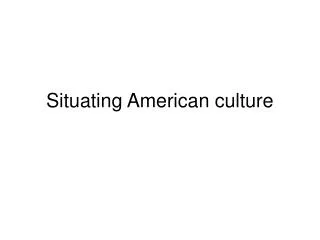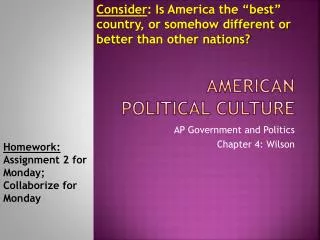American Culture
American Culture. Chapter 8 - Ethnic and Racial Diversity in the United States. Melting Pot or Salad Bowl. Large variety of ethnic groups (race, nationality, religion) These groups have been assimilated – to greater or lesser extent (melting pot – salad bowl)
Share Presentation
Embed Code
Link
Download Presentation
- unpaid slave labor
- white culture
- groups
- cultural diversity
- american jews
- illegal segregation

naoko + Follow
Download Presentation
American Culture
An Image/Link below is provided (as is) to download presentation Download Policy: Content on the Website is provided to you AS IS for your information and personal use and may not be sold / licensed / shared on other websites without getting consent from its author. Content is provided to you AS IS for your information and personal use only. Download presentation by click this link. While downloading, if for some reason you are not able to download a presentation, the publisher may have deleted the file from their server. During download, if you can't get a presentation, the file might be deleted by the publisher.
Presentation Transcript
- American Culture Chapter 8 - Ethnic and Racial Diversity in the United States
- Melting Pot or Salad Bowl • Large variety of ethnic groups (race, nationality, religion) • These groups have been assimilated – to greater or lesser extent (melting pot – salad bowl) • Since 1776 many groups have been assimilated, but many also remain separate (some of these are bicultural – American but with distinct language/culture)
- Melting Pot or Salad Bowl • Many settlers arrived in the US before it was the US (especially Hispanics) and want to maintain their traditions and language (Spanish) • Most white Europeans have been completely assimilated into “American culture” exceptions are American Jews – who have tended to remain separate. • Possibly because of historical reasons, or maybe just ethnic pride
- The Establishment of the Dominant Culture • Most of the early settlers were from England. There were also a large number of African Americans. • ~3,200,000 White • ~760,000 African Americans • ~1,000,000 Native Americans
- The Establishment of the Dominant Culture • The white population had more people, money, and power – so defined the dominant culture – White Anglo-Saxon Protestant (WASPs). • European groups intermarried and mingled with little thought of any difference • Assimilation of minority white groups occurred without great difficulty
- The Establishment of the Dominant Culture • Dominant culture was therefore: • English speaking • Western European • Protestant • Middle class • Immigrants with similar characteristics were welcomed – had the same basic values
- The Assimilation of Non-Protestant and Non-Western Europeans • Groups that were more like the dominant group were more readily accepted • Groups that were very different were often seen as a threat to American values and way of life. • Many Immigrants from the southern and Eastern Europe arrived during late 19th century • Usually poor • Didn’t speak English • Catholic or Jewish • Many Americans feared these new Americans would change America in undesirable ways
- The Assimilation of Non-Protestant and Non-Western Europeans • Americans therefore gave English instruction and citizenship classes to teach American beliefs • Many immigrants felt that this was not much help. • What they really wanted were jobs, food, houses.
- The Assimilation of Non-Protestant and Non-Western Europeans • “Political Bosses” were more helpful to immigrants – in exchange for their votes. • However, many bosses were seen as corrupt, and destroying American values • Immigrants were not self-reliant, and there was no competition for political office • Some see the bosses as a necessary evil – who helped to assimilate large numbers of immigrants.
- The Assimilation of Non-Protestant and Non-Western Europeans • As immigrants improved their standard of living, they came to accept most of the values of the larger American culture and were in turn accepted by it. • Therefore white ethnic groups tend to feel more American and less of their ethnic background than other groups.
- The African-American Experience • Non-white ethnic groups have not been so easily assimilated. • African Americans have had the greatest difficulty • Brought to America against their will – sold as slaves • Other groups came voluntarily
- The African-American Experience • Slavery was a complete contradiction to American values of Freedom and Equality of Opportunity. • It divided the US into the North (anti slavery) and the South (pro slavery – basis of economy) • Some Northern whites were against slavery for ethical reasons • Most Northern whites were against slavery because they feared they could not compete with unpaid slave labor.
- The African-American Experience • Abraham Lincoln was against slavery. • When he became President the Southern states left the Union to form their own country based on slavery. • This led to a Civil War (1861 – 1865). • The Northern States won and slavery was abolished.
- The African-American Experience • Although slavery was abolished, attitudes toward African Americans were slow to change, especially in the South. • Not allowed to vote • Segregated from whites (separate schools) • Inferior education • Poverty cycle • Racial prejudice
- The Civil Rights Movement of the 1950s and 1960s • In 1954 the Supreme Court declared that racially segregated education was unconstitutional • Black leaders were encouraged to seek an end to all segregation. • Martin Luther King Jr. – wanted greater assimilation of black people • Malcolm X – wanted separation of blacks from white culture • Black people have gained freedom from segregation and the right to vote
- The Civil Rights Movement of the 1950s and 1960s • The civil rights movement helped to assimilate blacks into larger American culture. • Affirmative action - • Requires employers to actively seek black workers • Requires universities to recruit black students • Has improved blacks situation in the US – Mayors of major cities, Supreme court, politicians
- An American Paradox • All minorities in the US benefited from the civil rights movement • Also advanced the rights of women, and reinforced the ideal of equality of opportunity. • Despite the decline of illegal segregation, most ethnic groups still live separately. • These provide valuable support to new immigrants, and provide a glimpse of other cultures for most white Americans
- An American Paradox • However, there is a negative side • There is a great different between different groups • Most minorities are underrepresented. • Many minorities live in inner cities, which are generally poorer, and unprivileged. • Immigrants of all backgrounds are still attracted by the American Dream • However, only those with money and education are likely to be very successful.
- A Universal Nation • In the 1920’s the US reduced the numbers of immigrants allowed into America. • Despite the worries of the dominant culture – immigrants did not radically change American values, but enriched the cultural diversity of the nation
- A Universal Nation • In 1965 changes were made to immigration laws that allowed more immigrants into the US, and removed bias toward European immigrants. • Most immigrants today are form Asia, Latin America, and the Caribbean. • There are also large numbers of illegal immigrants. • Some people see this a s beneficial – America may be come the first Universal Nation – large numbers of people from different cultures living under one government

AMERICAN CULTURE
AMERICAN CULTURE FROM SUPER GOAL 3 obey v. to do what someone in a position of authority tells you to do; or to do what a law or rule says you must do brochure n. a thin book giving information or advertising something
824 views • 22 slides

American Business Culture
American Business Culture. The American Experience and Value System Personal Qualities Communication Protocol Mores and Morality The Business Climate. American Business Culture. Political Correctness Employer-Employee Relations Salary and Benefits Socializing Negotiations.
2.94k views • 25 slides

American Culture
American Culture . Chapter 4 - The Frontier Heritage. American Frontier. American Frontier. The Impact of the American Frontier (1). The ‘frontier’ has not existed for more than 100 years, but it’s effects are still present today
553 views • 23 slides

Situating American culture
Situating American culture. Thomas Paine, Common Sense, 1776.
197 views • 4 slides

American Political Culture
American Political Culture. Habits of the Heart. Learning Objective. To understand what political culture is and how it may potentially impact political outcomes. What is Politics?. Harold Lasswell, “Who gets what, when, and how”
454 views • 16 slides

American Culture
The Context of Traditional American Values: Racial, Ethnic, Religious, and Cultural Diversity. Today, the US is the most diverse country in the worldRacially, ethnically, culturally, religouslyThe US has always had some diversityNative AmericansSpanish settlersFrench missionariesBlack slavesB
838 views • 29 slides

American Culture
American Culture. Art - Painters. Painted landscapes that showed the beauty of America. Thomas Cole. Landscapes, beauty, romantic images of nature, use of lighting A sense of optimism, nationalism, pride. Founder of the Hudson River School
714 views • 13 slides

African American Culture
African American Culture. Chapter 10, Section 5. Harlem Renaissance. Spanned 1919-mid 1930s Great Migration large African American populations in the north Cities full of night clubs and music Harlem neighborhood in New York City became epicenter
424 views • 14 slides

American culture
334 views • 9 slides

American Political Culture
Consider : Is America the “best” country, or somehow different or better than other nations?. American Political Culture. AP Government and Politics Chapter 4: Wilson. Homework: Assignment 2 for Monday; Collaborize for Monday . American political culture. What is “political culture?”
469 views • 23 slides

American Political Culture
American Political Culture. Chapter 4. “Culture has you before you have culture”. Culture is difficult to define Culture is learned Culture dictates what appears “normal” to you Culture changes continuously Influences the way you think about things
448 views • 11 slides

American Culture
American Culture. Section 3.3. Main Idea. Enlightenment ideas and the Great Awakening brought new ways of thinking to the colonists, and a unique American culture developed. Great Awakening. Focus on work and wealth distracted colonists away from their religious faiths.
308 views • 10 slides

American Culture
American Writers:. Washington Irving 1783 - 1859 Named after George Washington Writings often told about American History “Rip Van Winkle” “The Legend of Sleepy Hollow” Was a bridge between European literary traditions and a new type of writer who
439 views • 7 slides

American Culture
American Culture. Chapter 3: The American Religious Heritage. Freedom of Religion in the United States (1). Individual freedom (see last weeks lesson) allows Americans to practice any religion The high level of cultural diversity means there is a lot of religious diversity
866 views • 27 slides

ASIAN AMERICAN CULTURE
ASIAN AMERICAN CULTURE. Jennifer Stoddard CIT 506 January 14, 2009. Culture.
549 views • 10 slides

AMERICAN CULTURE
AMERICAN CULTURE. Colonial Life. Most people had English origins English language, traditions Self-government Colonial assemblies elected by white male property owners Two colonies had elected governors (RI and CT) Religious toleration
992 views • 70 slides

American Culture
American Culture . Chapter 10: How Americans Spend Their Leisure Time. Sports and American Values. Sports are a reflection of society Organized sports may have a serious social purpose Most popular sports are: Football Basketball Baseball Soccer. Sports and American Values.
973 views • 16 slides

American Culture
American Culture. Chapter 6: The World of American Business. The Characteristics of American Business (1). Businesses are directly/indirectly owned by private individuals/groups for profit There are also: Public, government owned institutions Nonprofit organizations (churches, charities etc)
472 views • 13 slides

American Culture
American Culture. Chapter 5: The Heritage of Abundance. A History of Abundance (1). Americans = 5% of world population Americans use 25% of world’s energy 7 pounds of garbage per person, per day This abundance has helped to shape the American character. A History of Abundance (2, 3).
401 views • 18 slides

American culture
Who am I Laura Mendoza Born and raised in Espoo, Finland Studied and worked in Seattle, USA for 10+ years English lecturer (Language Centre, TKK) Finland USA Mexico Finland. American culture. Objective:. To deepen our understanding of the American culture
1.08k views • 22 slides

American Culture
American Culture. Chapter 11: The American Family. Family Structures. For American Adults: Immediate family = wife/ husband + kids Other family = separate units (parents, siblings, etc) Extended family = Aunts, Uncles, Cousins, grandparents Traditional “family unit”
874 views • 17 slides

American Culture
Wednesdays 3:00 – 4:00. American Culture. What is an American. Individualism. Independent Not “tied to your mother’s apron strings” Self-reliant Stand out from the crowd. Competition. Comparing I’m number one. Privacy. I need space Appear aloof. Equality.
446 views • 11 slides
























